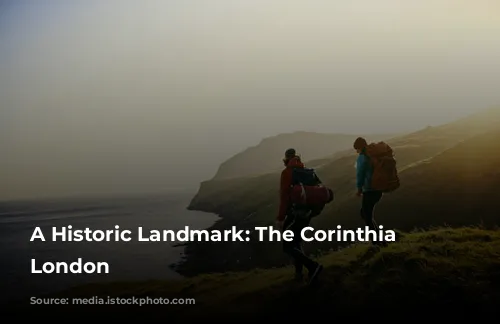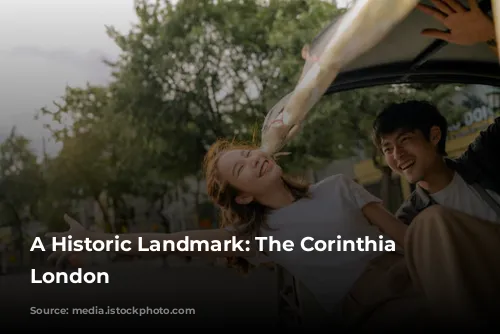Nestled in the heart of London, at the intersection of Northumberland Avenue and Whitehall Place, stands the magnificent Corinthia Hotel. Its prominent position, sandwiched between Trafalgar Square and the Thames Embankment, makes it a true landmark. This majestic structure boasts a rich history, having served as a luxurious hotel, a vital government building, and finally, once again, a prestigious hotel.
The Corinthia’s journey began in 1885 when it opened its doors as the Metropole Hotel. Situated near the Palace of Westminster and government offices in Whitehall, its strategic location made it a prime target for requisition during both World Wars. After the Second World War, the Ministry of Defence acquired the hotel and used it as its administrative offices until 2007. When the building became surplus to the government’s needs, it was sold by Crown Estates and underwent a meticulous restoration. The hotel was reborn as the Corinthia, blending the best of hotel and residential accommodations.
A Blend of History and Luxury
The Metropole’s construction, spearheaded by the Gordon Hotels company, started in 1883. Upon its grand opening in 1885, the hotel was a sensation, boasting an impressive 88-page brochure that showcased its luxurious amenities. Over the years, it became a magnet for the elite. The Aero Club and the Alpine Club hosted their annual dinners there, and the first London to Brighton run in 1896 used the hotel as its starting point. Prince of Wales, later King Edward VII, was a frequent guest, even having a reserved box in the ballroom and a dedicated Royal Suite.
During the First World War, the hotel was once again commandeered by the government, this time to house government staff. Even the Commanders-in-Chief of the British Expeditionary Force, Field Marshals John French and Douglas Haig, stayed at the hotel the night before the troops embarked for France. After the war, the hotel re-opened as a hotel and hosted the popular “Midnight Follies” cabaret.
In 1921, a young musician named Bert Firman landed a job as a violinist with the Midnight Follies Orchestra. Fate intervened when the bandleader, an American saxophone player, became incapacitated, and Firman, at the tender age of sixteen, was appointed as the new bandleader. He became the youngest bandleader in the world and went on to lead the orchestra until 1924.
A Hub of Historic Events
In 1936, the Metropole Hotel hosted a momentous event in English rugby history. The England team, led by Prince Alexander Obolensky, defeated the touring New Zealand All Blacks 13-0, marking England’s first-ever victory over the formidable New Zealanders. Obolensky’s name became synonymous with rugby legend, thanks to his spectacular try, widely considered one of the greatest ever scored. The England team celebrated their victory at the Metropole, sharing the evening with the New Zealand team, who also happened to be staying at the hotel.
The government, needing more office space, leased the entire hotel in mid-1936, initially for the Ministry of Labour and the Ministry of Transport. Later, the Air Ministry and the Ministry of Defence occupied the hotel. During the build-up to World War II, the government extended the lease and once again used the hotel as their headquarters. Room 424 became the original home of MI9 and the Special Operations Executive, making the hotel a central hub for wartime operations.
After the war, the hotel was purchased from Gordon Hotels and added to the Crown Estate portfolio. The Ministry of Defence used it as an administrative building, with the Air Ministry becoming a major occupant in 1951. The Defence Intelligence Staff made the Metropole their base from the mid-60s until 1992. The hotel was often featured in the James Bond comic strip in the Daily Express, even serving as the fictional headquarters of MI6.

Redefining Luxury in the 21st Century
The Metropole stood unoccupied for several years until 2007, when it was acquired by a consortium for a staggering £130 million. The consortium, made up of Malta’s IHI plc and two of its major shareholders, the Libyan Foreign Investment Company and Nakheel Hotels of Dubai, planned to transform the building into a luxurious hotel and residential complex.
In 2008, the City of Westminster council approved the development, paving the way for the hotel’s grand reopening in 2011. The hotel was renamed the Corinthia, a name synonymous with luxury and sophistication. The adjoining 10 Whitehall Place was converted into 12 luxurious residences, and the hotel also added a state-of-the-art spa run by Espa.
The Corinthia Hotel has not only become a hub for luxury and hospitality but also a favoured location for filming. The hotel played a prominent role in the 2018 thriller “Red Sparrow,” with scenes being shot both inside and outside the hotel. The film’s press junket and photocall were also held at the hotel, adding to its growing fame.
The Corinthia Hotel, with its rich history and timeless elegance, remains a true jewel in the crown of London. This landmark, steeped in history, seamlessly blends the grandeur of the past with the modern luxuries of the present, making it a destination for the discerning traveler.











